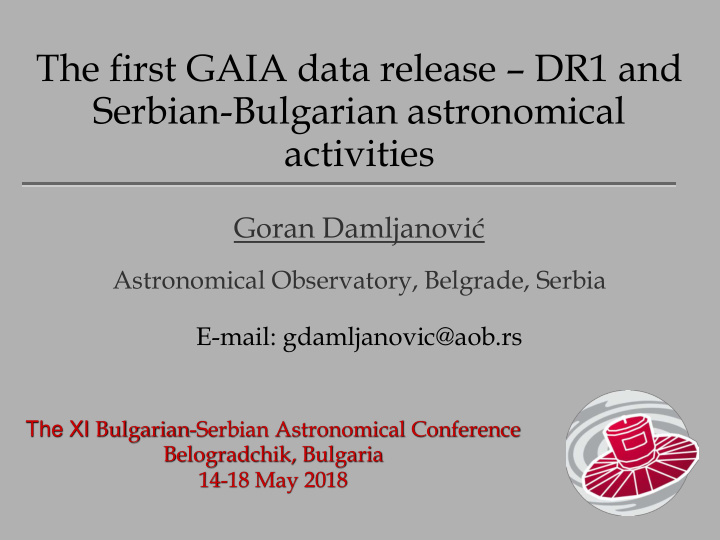



The first GAIA data release – DR1 and Serbian-Bulgarian astronomical activities Goran Damljanovi ć Astronomical Observatory, Belgrade, Serbia E-mail: gdamljanovic@aob.rs The XI Bulgarian-Serbian Astronomical Conference Belogradchik, Bulgaria 14-18 May 2018
Introduction ❖ FK5 (~1500 stars, +), XXIII IAU General Assembly in 1997 (Kyoto), Hipparcos Catalogue (ESA 1997) ~118000 stars, HIgh Precision PARallax COllecting Satellite (Nov 1989 – March 1993), J2000 equator, on the ICRS at epoch 1991.25, Tycho (~ 1 million stars) and Tycho-2 (~ 2.5 million stars) Catalogues, Hipparcos-2 (van Leeuwen 2007) – new reduction. ❖ Gaia ESA mission, in astrometry and photometry until V=20 mag or ~1 billon sources and to 16 mag in spectroscopy or ~150 million objects (Prusti 2012). Gaia celestial reference frame - Gaia CRF in the future (QSOs based one). ❖ “Serbian -Bulgarian mini- network telescopes” was established at 2013, and ~ 50 Gaia Alerts objects were observed during 3 years.
Gaia DR1 (2016) and DR2 (2018) ❖ GAIA (Global Astrometric Interferometer for Astrophysics). Astrometrically, photometrically and spectroscopically surveying the full sky. The ESA space astrometry mission or Gaia satellite (Dec 2013). The Gaia DR1 (September 2016) and DR2 (April 2018). ❖ DR1: 14 months, ~ 2 million stars (Tycho-Gaia astrometric solution). DR2: 22 months, 1.3 billion stars at J2015.5 and 0.4 billion faint sources. - Paper (Taris, Damljanovic, Andrei et al. 2018). ❖ About 3000 Gaia Alerts (by the Gaia Science Alerts group) during 3 years (until October 2017).
Mini-network (3 sites, now 6 telescopes): ❖ 60cm (mid-2011) and 1.4m tel.(mid-2016) of Astronomical Station Vidojevica - ASV of Astronomical Observ. in Belgrade - AOB (Serbia), ❖ 2m, 60cm and 50/70cm Schmidt-camera at Rozhen Obs., National Astronomical Observatory (NAO) of Bulgarian Academy of Sciences (BAS), ❖ 60cm Belogradchik AO (Bulgaria). -The Gaia Alerts test-phase (Damljanovic et al.2014) - And the 1.31m ARIES (Aryabhatta Research Institute of observational sciencES, India) tel. - Johnson UBV and Cousins RI filters.
ASV, Belogradchik and Rozhen
The instruments: 1 ) 60 cm Cassegrain (long.=21.5º, lat.=43.1º, h=1136m), CCD Apogee Alta U42, ASV (Serbia), 2 ) 1.4m (21.6, 43.1, 1143m), CCD Apogee Alta U42, ASV(Serbia), 3) 2m Ritchey-Chrétien (24.7º, 41.7º, 1730m), CCD VersArray 1300B (April 2018), Rozhen Obs. (Bulgaria), 4) 60cm Cassegrain (24.7º, 41.7º, 1759m), CCD FLI PL09000, Rozhen Obs. (Bulgaria), 5) 50/70cm Schmidt-camera (24.7º, 41.7º, 1759m), CCD FLI PL16803, Rozhen Obs. (Bulgaria), 6) 60cm Cassegrain (22.7º, 43.6º, 650m), CCD FLI PL09000, Belogradchik (Bulgaria).
The 1.4m ASV (Serbia), since mid-2016
BELISSIMA project, Ritchey-Chrétien, Nasmyth
Optical observations of Gaia Alerts, Gaia-FUN-TO 1) The ASV (D/F=0.6/6m) tel. The CCD Apogee Alta U42: 2048x2048 pixels, pixel size is 13.5x13.5 μm, scale is 0.˝465/pixel, FoV=15.8x15.8’, + SBIG ST10 XME & Apogee Alta E47. 2) The R.C. (D/F=2/15.77m) tel. of Rozhen National Astronomical Observatory (NAO) of Bulgarian Academy of Sciences (BAS). The CCD VersArray 1300B: 1340x1300, 20x20µm, 0.˝261/px, 5.6x5.6’, + Andor iKon-L from April 2018 (2048x2048, 13.5x13.5 μ m, 0.˝17/px ). . Schmidt-camera 50/70cm
3) The 60cm Rozhen (F=7.5m) tel. The CCD FLI PL09000: 3056x3056, 12x12 μm, 0.˝33/pixel, 16.8x16.8 ‘ ; under reconstruction from 2016. 4) The 50/70cm Schmidt-camera (F=1.72m), Rozhen. The CCD FLI PL16803: 4096x4096, 9x9 μm, 1.˝08/pixel, 73.7x73.7 ′ . 5) The 60cm Belogradchik (F=7.5m) tel. The CCD FLI PL09000: 3056x3056, 12x12 μm, 0.˝335/pixel, 16.8x16.8'. 6) The 1.4m ASV (F=11.42m) tel. since mid-2016. The CCD Apogee Alta U42: 2048x2048, 13.5x13.5 μm, 0.˝243/pixel, 8.3x8.3’, new Andor iKon -L 936 (2048x2048 pixels, 13.5x13.5 μ m), new EMCCD Andor iXon 897 for lucky imaging.
1.31m ARIES (Manora Peak, Nainital, India) ARIES - A ryabhatta R esearch I nstitute of observational scienc ES R.C. Cassegrain (long.=79.6ºE, lat.=29.35ºN, h=2420m), central Himalayan region. CCD: 2048x2048 pixels, pixel size is 13.5x13.5 μm, scale is 0.˝541/pixel, FoV=18.5x18.5’, 21 -25Nov.2016 (Gaya16aye, 6 times).
Gaia16aye, R-filter(Exp.=40s), June19 th 2017, 1.4m ASV.
Observed objects (~20) during 2017: ❖ 1.4m ASV (5 objects) : Gaia16aye(11 times), Gaia17arv(1), Gaia17asa(1), Gaia17asc(1), Gaia17aru(1). ❖ 60cm ASV (14) : Gaia16aye(11), Gaia16bnz(2), Gaia17bsu(1), Gaia17bsp(1), Gaia17bsr(1), Gaia17bts(7), Gaia17bxh(1), Gaia17chf(1), Gaia17cgo(1), Gaia17che(1), Gaia17cpa(1), Gaia17cut(1), Gaia17cup(1), Kojimaevent(1). ❖ 60cm Belogradchik (1) : Gaia17ade(2). ❖ 2m Rozhen - FoReRo2 (1): Gaia16aye(4). ❖ 50/70cm Schmidt-camera (5): Gaia17asc(1), Gaia17arv(1), Gaia17asa(1), Gaia17chf(1), Gaia17bts(1). ❖ 60cm Rozhen : - (under reconstruction from 2016). -Gaia16aye (Ayers Rock): 18 times in 2016, and 26 in 2017; paper in A&A (2018?). Object Gaia14aae (Campbell et al. 2015).
Conclusions ❖ The Gaia-FUN-TO (~20 objects in 2017, ~50 in 2014 -2017) using 6 telescopes, and BVRI filters; the seeing=1.˝0 to 3.˝5 (mean~1.˝2 at ASV,it could be 0.˝7 at Rozhen and ASV). ❖ During 2017, there are: ~380 points using 60cm ASV tel., ~180 ones with 1.4m ASV (Serbia), ~10 at 2m Rozhen, 60 at Schmidt-camera (Rozhen), and ~20 at 60cm Belogradchik (Bulgaria); ~620/year (~1850 for 3 years), 60cm Rozhen: - . ❖ It is possible to observe the objects until V~20mag by using 2m Rozhen or 1.4m ASV (Exp.time. ~5min), or until V~19mag with smaller instruments. ❖ The 1.4m tel. at ASV site from mid-2016 via Belissima project. New Andor iKon-L 936, new EMCCD Andor iXon 897 for lucky imaging. Also, new CCD Andor iKon-L on 2m Rozhen.
Thank you!
Recommend
More recommend